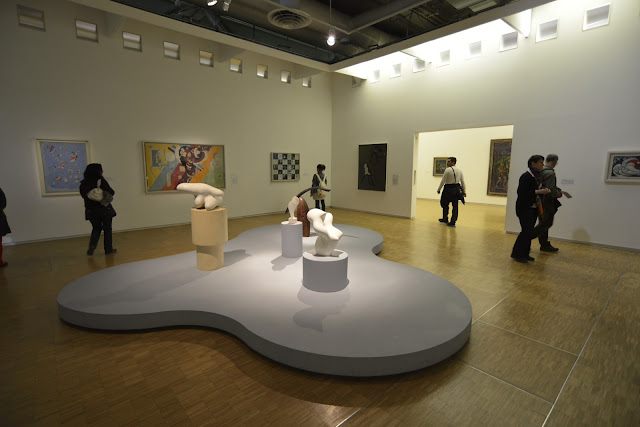Beaubourg Museum of Modern Art
While I’ll leave the serious and scholarly art history
dissertations to my wife – she’s the one with the degree in art history – as I
see it, European fine art had its basis in the Catholic Church, nation states
and royalty via commissioning various works to their pleasure or political
motivations. Art of the time was filled with symbolism and attempts at
near-photographic imagery. Superb craft was developed over time to where it can
be nearly impossible to distinguish the painted piece from a photograph from
any reasonable distance.
As artists started painting for their own self expression –
often driven to extremes just to continue that opportunity – artists drew us in
with a new way of looking at that which could now be reproduced more accurately
via a photograph; hence the Impressionists. They wanted us to see and feel what
they saw and felt. They wanted us to see the world in a less mundane way than a
highly accurate translation of a scene now made possible via photography.
Which is why the “Beaubourg” or the Centre Georges Pompidou museum
is such a refreshing place. It is at the same time a stark, utilitarian
structure that infuses a deep sense of minimalist architectural design yet it
often supports pure, unbridled whimsy. Initially the Beaubourg was not well
received. National Geographic described it as “love at second sight,” other’s
described it as Paris’ own Lock Ness monster.
(Yes, the girls are looking at empty frames arranged as family photos might be in a suburban home.)
If you want to see the old masters, including La Giaconda
(Da Vinci’s Mona Lisa) go to the Louvre. For Impressionists and other fine art,
the D’Orsay moves you into the early 1900’s. But it is the Pompidou (designed
by Richard Rogers, Renzo Piano and Glanfranco Franchini in 1971 and completed
1977) that will bring you from the 1960’s to today. Whether it's the Stravinsky
Fountain (Fontaine des Automates) -- a reflecting pool opposite centuries old
architecture -- populated with brightly painted whimsical, moving,
water-spraying, imaginary creatures, representing Stravinsky musical themes, or
a perforated steel installation in the main galleries that’s part cave, part
labyrinth, or simply a visual delight, the art engages you, invites you to be a
part of it.
That’s not to say you won’t find significant works by
Picasso, Mondrian, Chagall or others. There’s simply an opportunity to find art
that does more than make you say, that’s interesting.
In addition to the exhibition space there is an open-air
restaurant on level six as well as a wonderful observation deck / reflecting
pool terrace. The views of downtown Paris are simply absorbing. It’s also a
nice respite from the art, a bit like cleansing your palette between courses of
a fine meal with a citrus sorbet.
But either before entering the museum, or before leaving for
the day, take time to absorb another function of the facility, the plaza (Place
Georges Pompidou). You’ll find families having picnics, probably didgeridoo
players looking for tips as they play along with pre-recorded music tracks,
street vendors hawking kitschy Eiffel Tower key rings and table-top mementos, jugglers,
mimes, artists, or just about anyone else exhibiting their prowess at some
arcane craft or athletic endeavor.
Set off to one end of the plaza in its own building is the Atelier
Brancusi sculpture museum that is an interpreted replica of the artist’s exhibition
studio and work rooms… behind glass. Brancusi, as did Rodin, left his entire
estate and personal collections to the French State.
The facility was designed as the artist bequeathed before
his death by Renzo Piano to not so much duplicate Brancusi’s actual studio, but
to create an accessible space that preserved his sense of negative space and
light; so much so that the lighting itself was designed to duplicate the
natural light of Brancusi’s actual studio. The light and negative space was
especially important because much of what the artist intended was a function of
the materials used, the space around it and the light surrounding it.
Finally, across the plaza, a pistache (pistachio) gelato
goes a long way to delight yet another sense to complete the day.



























No comments:
Post a Comment